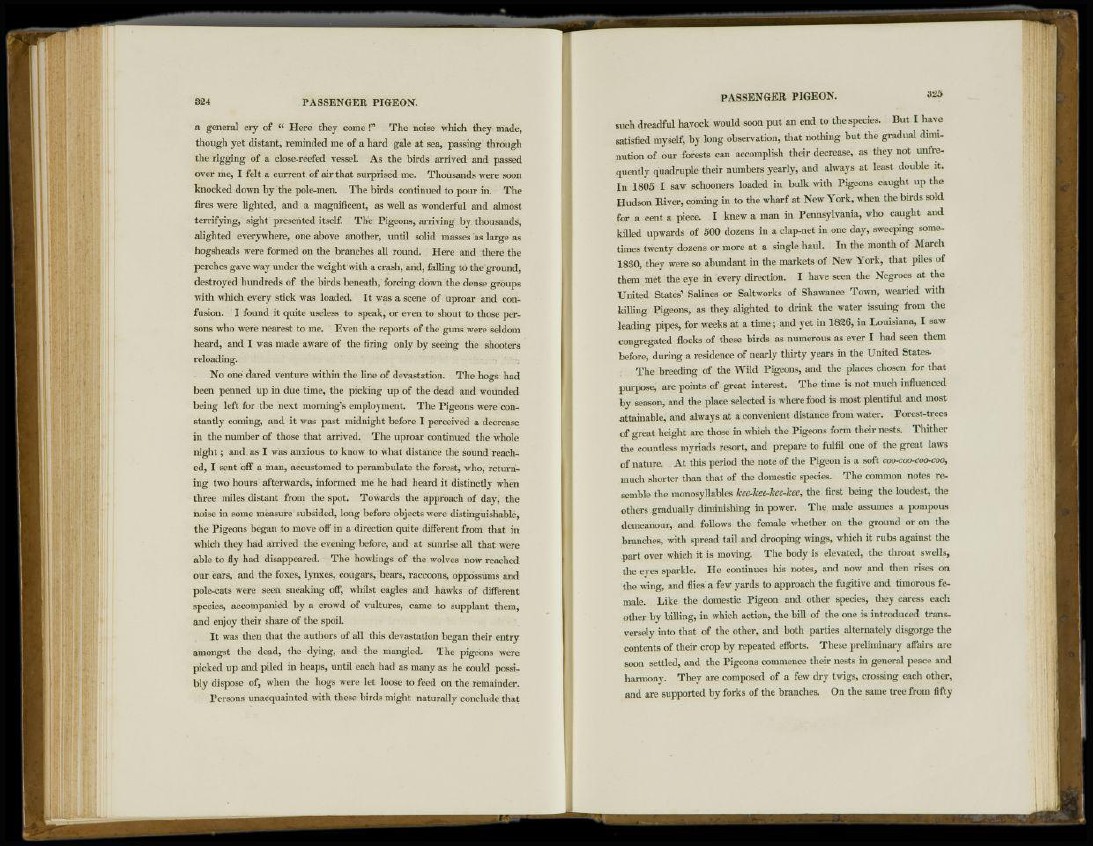
a general cry of " Here they come !" The noise which they made,
though yet distant, reminded me of a hard gale at sea, passing through
the rigging of a close-reefed vessel. As the birds arrived and passed
over me, I felt a current of air that surprised me. Thousands were soon
knocked down by the pole-men. The birds continued to pour in. The
fires were lighted, and a magnificent, as well as wonderful and almost
terrifying, sight presented itself. The Pigeons, arriving by thousands,
alighted everywhere, one above another, until solid masses as large as
hogsheads were formed on the branches all round. Here and there the
perches gave way under the weight with a crash, and, falling to the ground,
destroyed hundreds of the birds beneath, forcing down the dense groups
with which every stick was loaded. It was a scene of uproar and confusion.
I found it quite useless to speak, or even to shout to those persons
who were nearest to me. Even the reports of the guns were seldom
heard, and I was made aware of the firing only by seeing the shooters
reloading.
No one dared venture within the line of devastation. The hogs had
been penned up in due time, the picking up of the dead and wounded
being left for the next morning's employment. The Pigeons were constantly
coming, and it was past midnight before I perceived a decrease
in the number of those that arrived. The uproar continued the whole
night; and as I was anxious to know to what distance the sound reached,
I sent off a man, accustomed to perambulate the forest, who, returning
two hours afterwards, informed me he had heard it distinctly when
three miles distant from the spot. Towards the approach of day, the
noise in some measure subsided, long before objects were distinguishable,
the Pigeons began to move off in a direction quite different from that in
which they had arrived the evening before, and at sunrise all that were
able to fly had disappeared. The howlings of the wolves now reached
our ears, and the foxes, lynxes, cougars, bears, raccoons, oppossums and
pole-cats were seen sneaking off, whilst eagles and hawks of different
species, accompanied by a crowd of vultures, came to supplant them,
and enjoy their share of the spoil.
It was then that the authors of all this devastation began their entry
amongst the dead, the dying, and the mangled. The pigeons were
picked up and piled in heaps, until each had as many as he could possibly
dispose of, when the hogs were let loose to feed on the remainder.
Persons unacquainted with these birds might naturally conclude that
such dreadful havock would soon put an end to the species. But I have
satisfied myself, by long observation, that nothing but the gradual diminution
of our forests can accomplish their decrease, as they not unfrequently
quadruple their numbers yearly, and always at least double it.
In 1805 I saw schooners loaded in bulk with Pigeons caught up the
Hudson River, coming in to the wharf at New York, when the birds sold
for a cent a piece. I knew a man in Pennsylvania, who caught and
killed upwards of 500 dozens in a clap-net in one day, sweeping sometimes
twenty dozens or more at a single haul. In the month of March
1830, they were so abundant in the markets of New York, that piles of
them met the eye in every direction. I have seen the Negroes at the
United States' Salines or Saltworks of Shawanee Town, wearied with
killing Pigeons, as they alighted to drink the water issuing from the
leading pipes, for weeks at a time; and yet in 1826, in Louisiana, I saw
congregated flocks of these birds as numerous as ever I had seen them
before, during a residence of nearly thirty years in the United States.
The breeding of the Wild Pigeons, and the places chosen for that
purpose, are points of great interest. The time is not much influenced
by season, and the place selected is where food is most plentiful and most
attainable, and always at a convenient distance from water. Forest-trees
of great height are those in which the Pigeons form their nests. Thither
the countless myriads resort, and prepare to fulfil one of the great laws
of nature. At this period the note of the Pigeon is a soft coo-coo-coo-coo,
much shorter than that of the domestic species. The common notes resemble
the monosyllables kec-kee-Icee-Tcee, the first being the loudest, the
others gradually diminishing in power. The male assumes a pompous
demeanour, and follows the female whether on the ground or on the
branches, with spread tail and drooping wings, which it rubs against the
part over which it is moving. The body is elevated, the throat swells,
the eyes sparkle. He continues his notes, and now and then rises on
the wing, and flies a few yards to approach the fugitive and timorous female.
Like the domestic Pigeon and other species, they caress each
other by billing, in which action, the bill of the one is introduced transversely
into that of the other, and both parties alternately disgorge the
contents of their crop by repeated efforts. These preliminary affairs are
soon settled, and the Pigeons commence their nests in general peace and
harmony. They are composed of a few dry twigs, crossing each other,
and are supported by forks of the branches. On the same tree from fifty